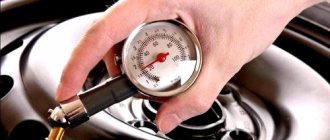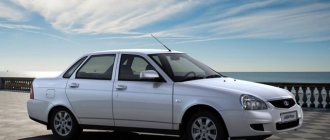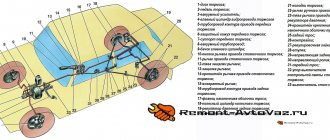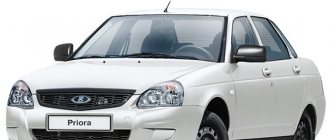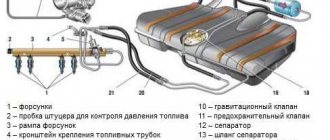The domestic auto industry rarely spoils us with new vehicles, so there is not much variety of Russian cars on the roads. However, many car enthusiasts who own cars such as the VAZ 2107 or 2114 or 2115 do not want to part with them and drive them around the expanses of Russia for many years. No one can explain why Lada is so popular in our time - this is the second name for these cars. Everyone has their own reasons for not parting with their “old friend.”
VAZ tire
Since many VAZ car models have not rolled off the assembly line for a long time, one cannot expect that they will be equipped with the latest functions. Naturally, their safety is a complete disaster; apart from a seat belt, there is no protection. Experienced drivers increase the safety of their lives by always monitoring the tire pressure of their VAZ car. In addition, this allows us to reduce wear and tear on vehicles, which is important.
WHAT IS THE RISK OF DEVIATION FROM THE SET PARAMETERS
Front-wheel drive cars of the Volzhsky Automobile Plant, such as the VAZ 2110, VAZ 2114 and VAZ 2115, can be equipped with wheels with a radius of R13, R14, R15 and R16, but the standard cars are equipped only with rims and tires of the 13th and 14th radius. The optimal tire pressure depends primarily on the load and weight of the vehicle; much also depends on road conditions and ambient temperature.
If the wheels are poorly inflated, then:
- The tire tread will wear out faster;
- It will become more difficult to control the car and turn the steering wheel harder;
- Fuel consumption will increase, and the more flat the tires, the more noticeable the gasoline consumption;
- The car will become prone to skidding, especially on wet and snowy roads, and stability will be lost;
- The power of the car will decrease as the resistance to movement will increase.
If the wheels are inflated more than normal, then this is also not very good:
- When driving, you can feel all the unevenness of the road surface and the ride becomes uncomfortable. In addition, the chassis wears out faster;
- Due to less grip on the road surface, the braking distance is longer, which has a detrimental effect on traffic safety;
- The tire tread wears unevenly, and the service life of the tires is noticeably reduced;
- A hernia may appear on the wheel, and under high pressure when hitting an obstacle, the rubber may rupture, which is completely unsafe at high speed.
Below are three pictures that show how the rubber tread adheres to the road at optimal, low and excess pressure.
Many car owners are wondering what pressure should be in R14 tires on VAZ models. According to technical conditions, the wheels on a VAZ 2114 (2115) car are inflated to 1.9 kgf/cm² (R13), on VAZ 2110-2112 cars it is recommended 2.0 kgf/cm² (R14). Moreover, it makes no difference what axle the wheels are on - front or rear.
Review of the best summer and winter tires
It is better to acquire separate sets of summer and winter tires in advance. Pirelli Cinturato P1 Verde tires are ideal for the warm season. Their cost is relatively high (from 3,500 rubles per 1 tire). However, they perform excellently on wet asphalt and are highly resistant to wear.
- Continental Conti Premium Contact 5 is well balanced. There are a large number of special drainage channels - they make it easy to drain water from the contact patch. This kit will cost slightly less than the one discussed above.
- Goodyear EfficientGrip Performance provides good grip and low fuel consumption. However, the tread thins out quite quickly - especially during intense driving. The rubber is soft and handles well. Despite its softness, it is difficult to damage it redder.
- Dunlop Sport BluResponse is relatively cheap compared to all the options discussed above. However, it has its weaknesses. For example, on wet asphalt the wheels slip a lot and handling deteriorates.
- Semperit Comfort-Life 2 is a rare guest on Russian territory. However, on dry asphalt at positive temperatures it performs more than well. However, rubber is distinguished by its noise.
- GOODYEAR 175/70R14 UG ICE ARCTIC D-STUD - studded tires at a relatively low cost. Regardless of the ambient temperature, it retains its flexibility and softness. Cost – from 4,000 rubles.
- HANKOOK 175/70R14 W429 is a more budget option. Cost – from 2,800 rubles. Thanks to the deep tread and flexible design, the driver can feel completely safe on the road.
- KUMHO 175/70R14 WI31 84T usually costs several hundred rubles cheaper than the modification discussed above. The presence of studs makes this tire safe on almost any road.
- VIATTI TIRES 175/70R14 BRINA NORDICO is manufactured using rubber mixing technology. Reinforced lugs make this model indispensable not only in winter, but also on dirt roads in summer.
- SAVA 175/70R14 ESKIMO ICE MS is the most profitable option. It has a relatively low price (from 2,000 rubles). There are no thorns. However, the deep tread and its shape provide high-quality, reliable contact with any surface.
Choosing suitable tires for the VAZ 2110 is a relatively simple process. However, it is important to familiarize yourself with the intricacies of tire selection in advance. Wheels that are too large can easily damage the vehicle body.
INFLUENCE OF WEATHER CONDITIONS AND ROAD FACTORS
The pressure in VAZ tires in summer should, in principle, be the same as in winter. But in practice in winter it is made a little lower for a number of reasons:
- Slightly lower tires allow you to better control the car on slippery roads, it becomes more stable;
- The suspension is made softer, and road unevenness is less felt;
- The braking distance becomes shorter, reducing the likelihood of an emergency.
It is necessary to take into account the fact that after a temperature change (after leaving a warm garage on a frosty street), the pressure in the R14 tires will become less due to physical factors. Therefore, you should check it before you hit the road and, if necessary, pump up the tires. Also, when it gets warmer after winter, pressure measurements should be taken.
The pressure in R13 tires in summer is usually maintained at 1.9 atm, but this level is designed for an average vehicle load (two or three people in the cabin). If the car is fully loaded, then the pressure should be increased on the front axle to 2.0-2.1 atm., on the rear axle to 2.3-2.4 atm. The spare wheel is inflated to 2.3 atm.
Russian roads are not of good quality, and therefore many car owners deliberately lower the tire pressure somewhat so that all the unevenness of the road surface is not so noticeably felt when driving. Typically, in summer the wheels are lowered by 5-10%, and in winter by 10-15% of the norm. On flat roads you can stick to the factory standard.
For example, a table of car tire pressures:
For example, a table of car tire pressures
What pressure should be in the wheels of a VAZ 2110
During the period of operation of the vehicle, it is necessary to constantly monitor the pressure in the tires of the VAZ 2110. The value must be within certain limits.
Overestimated or underestimated indicators lead to negative consequences. Inflating the wheels reduces the degree of deformation of the rubber, which leads to a decrease in the tire's contact area with the road. Strong pumping leads to a deterioration in the absorption of impacts from various road obstacles. Driving a car becomes more difficult. Weakly inflated wheels on Lada also create a number of problems. It becomes more difficult to overcome road resistance due to the increased contact patch of the tires, and fuel consumption increases. It appears on poor-quality roadways, where any bump slows down the movement of the car.
LARGER DIAMETER WHEELS
From the factory, the installation of wheels with diameters R15 and R16 is not provided, but some car enthusiasts, in pursuit of fashion and improved technical characteristics, install them on their VAZs. And accordingly, you need to know what the pressure should be in the R15 tires, and what the pressure should be in the R16 tires. It all depends on the workload of the VAZ model. With an average vehicle load, the wheels are inflated to 2 kgf/cm²; on a loaded car, it is better to inflate them to 2.2 kgf/cm². And if there is a lot of heavy luggage in the trunk, then the rear tires are pumped up by another 0.2 kgf/cm². It turns out that the pressure in R14 tires is approximately the same as the pressure in R15 and R16 tires (for VAZ 2110-2115 models).
What tire sizes does the manufacturer recommend to install?
The standard size depends on the body type. Moreover, all cars without exception used discs with a hub diameter of 58.5 mm. The amount of overhang could fluctuate - within 37-40 mm. The rim width is also typical - 5-5.5J. The most common model is 2110. This digital combination is used to mark a car with a sedan body.
The manufacturer recommends the following sizes:
- 2110, 21101, 21102 – 175/70 R13;
- 21103, 21104 – 175/65 R14.
"Razboltovka" - 4x98 mm. A special modification is the VAZ 21108 Premier car. The car was produced for a relatively short time - from 1999 to 2001. The only difference from previous versions is that alloy wheels with a diameter of 13 inches were installed at the factory. There are no fundamental differences for station wagon cars.
The issue was carried out between 1997 and 2004. The wheels installed at the factory differed depending on the modification of the car and the marking of the specific model:
- 2111 – 175/70 R15;
- 2111i-2114 – 175/65 R14.
Hatchbacks were produced, like most other cars in this series, until 2004. The diameter of the wheels and their dimensions also differed slightly depending on various factors:
- 2112 – 175/65 R14;
- 21122 – 175/70 R13;
- 21124 – 175/65 R14.
Using tires of standard size and diameter will avoid damage to the body and other troubles. However, the automaker suggests the possibility of installing custom-sized wheels.
METHODS OF MEASUREMENT
How to measure the tire pressure of VAZ cars? The measurement can be made using a special dial pressure gauge, but it should be noted that they may have an error of 0.2 atm. The pressure gauge can be either a separate device or as part of a wheel inflation pump.
We measure the pressure very simply:
- Reset the pressure gauge readings to zero;
- Remove the cap from the wheel spool (if there is one);
- Place the pressure gauge fitting on the nipple and press;
- We look at the arrow reading on the device.
It is recommended to take measurements at least once a month if the machine is used regularly. It is recommended to check tire inflation before leaving the garage after a long stay.
Pressure may increase when tires heat up. This often happens if the driver prefers a dynamic driving style with frequent and sharp braking. Therefore, measurements are taken on the car before the trip, when the wheels have not yet warmed up.
Tire pressure R14 VAZ 2110 in summer and winter
P14 tires are no exception. There is a standard amount of inflation in the summer for the front and rear. The value is 2.0-2.2 atm.
When driving on the highway, stick to maximum inflation - 2.2. The car moves with the necessary dynamics with an acceptable coasting. The mode corresponds to optimal fuel consumption. When driving on dirt or sand, the wheels are lowered to 2 a class=”aligncenter” width=”610″ height=”433″[/img]
In winter, it is necessary to reduce tire inflation by 0.1 atmospheres.
Pressure standards in the slopes of a VAZ 2110 car: table
The data presented is optimal for R13 and R14 . The parameters differ when using tires in summer, winter and when driving on good or bad roads. Tire marking information is presented in the table.
| Dimensions | Summer pressure in atm | Under load | in winter | On a good road | On a bad road | |||||
| Front | Rear | P | Z | P | Z | P | Z | P | Z | |
| 175/70R13 | 1,9 | 1,9 | 2,0 | 2,2 | 1,8 | 1,8 | 1,9 | 1,9 | 1,8 | 1,8 |
| 175/70R14 185/70R14 | 2,0-2,2 | 2,0-2,2 | 2,0 | 2,0 | 1,9-2,1 | 1,9-2,1 | 2,2 | 2,2 | 2,0 | 2,0 |
When operating a car for a comfortable and safe ride, it is better to adhere to these standards.
Specialization : Graduated from the State Automobile University, worked for 20 years at GAZ-56, now I drive a Zhiguli.
Source
About tire pressure on domestic VAZ cars
VAZ cars belong to the list of famous brands. These cars are still in great demand among Russian car enthusiasts. Numerous motorists who are ardent fans of domestic automobile production boldly purchase more modern models: VAZ-2107, 2110, 2112, 2114 and 2115. This indicates that even after the appearance of a large number of foreign cars, VAZ cars are still in demand. To ensure a long service life of the vehicle, every motorist must follow the recommendations of the manufacturer. Serious consequences can be avoided if the machine is used correctly, so it is very important to regularly check the tire pressure.
What does the pressure in Lada Vesta tires affect in winter?
The first factors that depend on the correct pumping are driving characteristics.
- Controllability. On excessively soft tires, the steering wheel begins to “float” and the car can pull to the side.
- Dynamics. Acceleration and braking accuracy suffer similarly. Flat tires do not grip the road well, which leads to safety problems.
- Possible damage. Snow tires are initially made from a soft compound. The pliable sidewalls become severely deformed when hitting an obstacle, which creates a risk of tire cutting or damage to the rims.
- Intensive wear of the working part of the tread.
Together, the factors reduce comfortable ride performance.
Why check tire pressure
Many motorists often wonder why they need to check tire pressure. What could this lead to? As a rule, deviation of this indicator leads to wear and damage to the rubber, resulting in poor off-road control of the vehicle.
What should the indicator be?
To know when maintenance is due, the manufacturer suggests considering the following options:
- If the criterion exceeds the norm, then any tire will become hard. There is an increased risk that you might hit a rock or pothole while driving, damaging the soft tires. Naturally, this is due to a deterioration in the quality of adhesion to the road surface.
- In this case, if the indicator does not meet the standards, then more fuel is consumed. There is a possibility of accelerating the wear process of products. Since due to the increased area the tire comes into contact with the road surface.
Frequency of indicator checking
Here a lot depends on the mileage of the vehicle. In particular, it is recommended to do checks at least twice a week. This is due to the fact that the structural elements of the tire do not have a perfect seal, so the air will still gradually escape. All-season tires are also in the “risk zone”, the pressure in which decreases with cold weather. Therefore, when choosing all-season tires, you need to take into account the need to inflate products in cold weather.
It is recommended to check this indicator on all tires (even those that are in the spare tire). In the absence of time to check such an important indicator, this process can only be performed if a long journey is planned. There is a category of car enthusiasts that clearly assesses the condition of tires. It is not recommended to trust your own intuition, because it can be wrong. For a long trip, it is best to thoroughly check the condition of each product.
In conclusion, it should be noted that checking the tire pressure of VAZ models (2107, 2110, etc.) is recommended 1-2 times a month. This applies to those countries where sudden temperature changes are observed. Failure to follow the manufacturer's recommendations will result in trouble while driving.
Source
The best way to pump tires
Just two decades ago, car enthusiasts had little choice. The only thing available was a hand pump, which was always kept in the luggage compartment of the vehicle.
The advantages of this option are simplicity and accessibility. The main disadvantage is high labor costs. On average, it is necessary to make about 110-130 up and down movements per atmosphere (for 13-14 inch tires).
After a while, a foot pump appeared, which was very easy to use.
Unlike the previous version, the hands were freed, and all the work was done with the foot.
The main disadvantage of such devices is their low reliability. After only 5-6 months of operation, the product simply failed (meaning inexpensive models).
Car enthusiasts breathed a sigh of relief when a compressor appeared - a special device that does its job independently.
All you need to do is plug in the device and observe the pressure gauge readings.
Once the tire pressure reaches the required value, you can turn off the compressor and hit the road.
But the downside of the first compressors was their connection to the household network.
Over time, compact products appeared that you could take with you on the road and pump up your tires at any convenient time.
The power supply for portable compressors is connected to the cigarette lighter or directly to the car battery.
Of course, the speed of inflating the wheel is less than in the case of a stationary compressor, but you can bring the tire pressure to the desired value at any time.
Recommended tire pressure for VAZ 2107/2110 and 2112
The manufacturer recommends the optimal degree of tire inflation for its own vehicle models, taking into account all design features and the load on the wheelsets.
The complex formula affects maximum loads, wheel speeds and the “degree of roughness” of domestic roads. Violating the parameters is strictly not recommended, as this may impair the predictability of the car.
You can find an indicator of what the tire pressure should be in the Lada Priora and other modern modifications in two indicators.
- Typically the metal tag is located on the B-pillar near the driver's door. The nameplate contains the necessary numbers and recommendations. On other models of the manufacturer, the information element may be located under the hood, in the trunk or on one of the pillars.
- Factory instructions. The owner's manual usually contains comprehensive information about service intervals, correct tire inflation, and factory recommendations.
Table of tire pressures for different models of domestic cars by make and wheel size
The unit of measurement can be determined only after studying the basic designation. For example, BAR is a popular option for reflecting an indicator. This designation refers to the technical atmosphere. Using a special tool, the indicator is measured in bars.
There are other factors that influence the parameter when measuring pressure in overinflated or uninflated tires.
These important factors include the following:
- wheel diameter;
- car brand;
- type of rubber used;
- road surface;
- driving style.
What instruments are used to measure this indicator?
This accessory is divided into three categories:
- pointer (works with a special spring);
- mechanical (based on a cylindrical spring);
- electronic is considered a more modern device on which a liquid crystal screen is installed.
The most popular is the first dial pressure gauge.
The main advantage of this development is reliability. In addition, every car owner can afford such a device due to its low cost.
Experts also highlight a shortcoming of the device. There is a possibility that it will immediately fail in the event of mechanical damage. Usually the spring breaks quite quickly, especially with a sharp impact. The second type of device is more effective - a mechanical pressure gauge. It is made in the form of a special “handle”.
Many car enthusiasts, despite the manufacturer’s recommendations, are interested in what the tire pressure should be. This is important to know for the safety of tires and road safety. Improper operation of the vehicle will lead to wear and damage to the tires. If the tire pressure is within normal limits, then a comfortable/safe ride is ensured. In addition, other positive qualities should be taken into account:
- the car is easy to drive;
- fuel is consumed in a minimum amount;
- tires wear out only after a few years.
To make it easier to determine the norm, a table of car tire pressures will be presented below.
Speed indices T - up to 190 km/h, H - up to 210 km/h.
Load capacity indices: 82-475 kg.
Rim offset (ET) is the distance from the mating plane of the disc to the middle of the rim.
TIRES INJECTION WITH NITROGEN
Recently, it has become fashionable to inflate wheels not just with air, but with nitrogen.
There is an opinion that:
- Nitrogen keeps pressure more stable, and when the wheel heats up, it does not change in the tires;
- Rubber does not age longer because the pumped air with nitrogen is cleaner;
- A steel wheel rim rusts less;
- The likelihood of rubber rupture is reduced, since nitrogen does not support combustion and reduces the risk of explosion.
But it seems that all the claims about nitrogen are just a publicity stunt. The air is already almost 80% nitrogen, and if its content inside the tire increases to 95%, little will change for the better.
Therefore, it is hardly worth giving in to the persuasion of sellers of dubious services and throwing money away. The only thing you can be sure of is that the wheels will not get worse from pumping nitrogen. If you don't mind the money, then you can try this innovation on your car.


